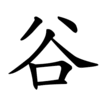谷
See also: 穀
| ||||||||
Translingual
| Stroke order | |||
|---|---|---|---|
 | |||
Han character
谷 (radical 150, 谷+0, 7 strokes, cangjie input 金人口 (COR), four-corner 80608, composition ⿳八人口)
- Kangxi radical #150, ⾕.
References
- KangXi: page 1189, character 1
- Dai Kanwa Jiten: character 36182
- Dae Jaweon: page 1652, character 19
- Hanyu Da Zidian: volume 6, page 3902, character 1
- Unihan data for U+8C37
Chinese
Glyph origin
| Historical forms of the character 谷 | |||
|---|---|---|---|
| Shang | Western Zhou | Shuowen Jiezi (compiled in Han) | Liushutong (compiled in Ming) |
| Oracle bone script | Bronze inscriptions | Small seal script | Transcribed ancient scripts |
 |
 |
 |
 |
| Characters in the same phonetic series (谷) (Zhengzhang, 2003) | |
|---|---|
| Old Chinese | |
| 螸 | *lo |
| 裕 | *loɡs |
| 容 | *loŋ |
| 溶 | *loŋ, *loŋʔ |
| 鎔 | *loŋ |
| 蓉 | *loŋ |
| 傛 | *loŋ, *loŋʔ |
| 褣 | *loŋ |
| 搈 | *loŋ |
| 瑢 | *loŋ |
| 嵱 | *loŋ |
| 熔 | *loŋ |
| 榕 | *loŋ |
| 塎 | *loŋʔ |
| 谷 | *ɦkroːɡ, *kloːɡ, *ɡ·loːɡ |
| 唂 | *kloːɡ |
| 焀 | *ɡloːɡ |
| 俗 | *ljoɡ |
| 欲 | *loɡ |
| 浴 | *loɡ |
| 鵒 | *loɡ |
| 峪 | *ɦkloːɡ |
| 鋊 | *loɡ |
| 輍 | *loɡ |
| 慾 | *loɡ |
Etymology 1
| simp. and trad. |
谷 | |
|---|---|---|
From Proto-Sino-Tibetan *kl(j)u(ŋ/k) (“river; gorge”). Cognate with Tibetan ལྗོངས (ljongs), Tibetan ཀླུང (klung) and Tibetan ལུང་པ (lung pa).
Pronunciation
Definitions
谷
Compounds
Derived terms from 谷
Pronunciation
Definitions
谷
Pronunciation
Etymology 4
| For pronunciation and definitions of 谷 – see 穀 (“corn; grain; cereal; salary; etc.”). (This character, 谷, is the simplified form of 穀.) |
Notes:
|
Japanese
Readings
From Middle Chinese 谷 (MC kuk̚, “valley, gorge”):
- Go-on: こく (koku, Jōyō)
- Kan-on: こく (koku, Jōyō)
- Kun: たに (tani, 谷, Jōyō); きわまる (kiwamaru, 谷まる)←きはまる (kifamaru, historical); や (ya, 谷); やつ (yatsu, 谷)
- Nanori: ひろ (hiro)
From Middle Chinese 谷 (MC jɨok̚), as in 吐谷渾 (Toyokukon, “Tuyuhun”):
From Middle Chinese 谷 (MC luk̚), as in 谷蠡 (Rokuri):
Compounds
Noun
Derived terms
Alternative forms
- 谷津
Derived terms
Derived terms
- 谷谷, 谷々 (yatsuyatsu)
- 谷七郷 (Yatsu Shichigō)
- 谷田 (yatsuda)
- 扇ヶ谷 (Ōgigayatsu)
- 葛西ヶ谷 (Kasaigayatsu)
- 亀ヶ谷 (Kamegayatsu)
- 桐ヶ谷 (Kirigayatsu)
- 月影ヶ谷 (Tsukikagegayatsu)
Derived terms
Noun
谷 (hiragana やち, rōmaji yachi)
- (regional) Same as やつ (yatsu) above
Alternative forms
- 谷戸
Noun
谷 (hiragana やと, rōmaji yato)
- Same as やつ (yatsu) above
Alternative forms
Korean
Vietnamese
This article is issued from
Wiktionary.
The text is licensed under Creative
Commons - Attribution - Sharealike.
Additional terms may apply for the media files.